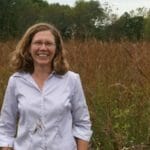Restoring Prairie Processes to Farmland
The prairie restoration in front of our home has never looked better than this year. It’s only a small swatch, but the lessons it provides have been huge.
Our prairie is a study in resiliency. Three inches of rain in a night? The prairie thrives. No rain at all for months? The prairie thrives. Cloudiness and cool temps? No problem. Blazing heat? Bring it on. This little prairie has even survived the fall of the neighbor’s 150-year oak (the grasses underneath battered but not even broken for the year).
What lessons does the prairie offer? The benefits of diversity. Conditions are always optimal for some of the four grasses and 15 forbs we planted. The prairie species grow and mature at different times, and harvest solar energy from early May until well after frost.
Another lesson of the prairie: Perenniality. According to Laura Jackson, “Perennial means that the plants come up from roots year after year instead of from seed, and as a consequence the physical structure of the vegetation—dry plant litter, crowns, and roots—protects the soil from erosion.” Laura, a PFI member and University of Northern Iowa biology professor, is co-author with her mother, Dana Jackson, of a wonderful book, The Farm as Natural Habitat.
Many of you are working to mimic the prairie’s diversity and perenniality in your farming systems. 32 percent of you report you have three-plus year rotations. 45 percent of you report you are using cover crops. 41 percent of you report you rotationally graze your livestock.
Part of Practical Farmers’ work is to help you solve the challenges to making those longer rotations, cover crops, and grazing systems work for your triple bottom line (profitability, stewardship, and community). We are so pleased that seven you are participating in PFI research this year to ground-truth the benefits of a three-year rotation over a two-year rotation of corn and soybeans. And that 67 of you are completing PFI cover crop research projects this year.

